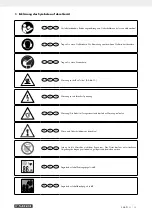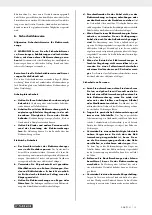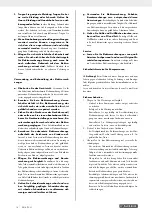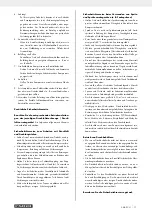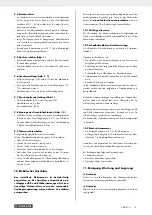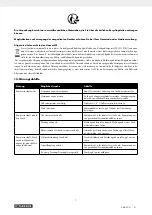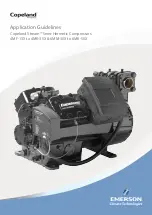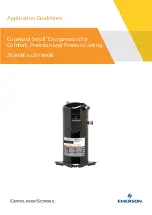
7
GB/IE
DANGER
The device and the packaging are not children‘s
toys! Do not let children play with plastic bags,
films or small parts! There is a danger of choking
or suffocating!
• Before connecting the machine, make certain that the data
on the type plate matches with the mains power data.
• Check the device for transport damage. Report any damage
immediately to the transport company which was used to
deliver the compressor.
• Install the compressor near the point of consumption.
• Avoid long air lines and supply lines (extension cables).
• Make sure that the intake air is dry and free of dust.
• Do not install the compressor in a damp or wet room.
• The compressor may only be used in suitable rooms (with
good ventilation and an ambient temperature from +5 °C
to 40 °C). There must be no dust, acids, vapours, explosive
gases or inflammable gases in the room.
• The compressor is designed to be used in dry rooms. It is
prohibited to use the compressor in areas where work is con-
ducted with sprayed water.
• The compressor may only be used outdoor briefly when the
ambient conditions are dry.
• The compressor must always be kept dry and must not be left
outdoors after work is complete.
9. Attachment and operation
m
Attention!
Always make sure the device is fully assembled
before commissioning!
You require the following for assembly:
1x open-ended spanner 14 mm
1x Phillips screwdriver
(not included in the scope of delivery)
9.1 Fitting the wheels (fig. 3)
• Fit the supplied wheels (5) as shown.
9.2 Installing the supporting foot (fig. 4)
• Fit the supplied supporting foot (7) as shown.
9.3 Installing the air filter (fig. 5, 6)
• Remove the transport lid (16) and screw the air filter (4) to
the equipment.
• Insert the hose (4d) into the opening of the air filter (4).
9.4 Mains connection
• The compressor is equipped with a mains cable with protec-
tive contact plug. This can be connected to any 230 V∼
50 Hz protective contact socket, with fuse protection of at
least 16 A.
• Before you use the machine, make sure that the mains volt-
age is the same as the operating voltage and the machine
power on the rating plate.
• Long supply cables, extensions, cable reels, etc. cause a
drop in voltage and can impede motor start-up.
• At low temperatures below +5 °C, sluggishness may make
starting difficult or impossible.
9.5 On/Off switch (fig. 1)
• Pull the On/Off switch (3) upwards to switch on the com-
pressor.
• To switch off the compressor, press the On/off switch (3)
down.
9.6 Setting the pressure (fig. 1, 2)
• Use the pressure regulator (15) to set the pressure on the
pressure gauge (12).
• The pressure set can be drawn from the quick couplings (10,
11).
• The vessel pressure can be read off at the pressure gauge (13).
9.7 Setting the pressure switch (fig. 1)
• The pressure switch (2) is set at the factory.
Cut-in pressure approx. 5.5 bar
Cut-out pressure approx. 8 bar
9.8 Fitting the compressed air hose (fig. 1, 2)
• Connect the plug nipple (14a) of the compressed air hose
(14) to one of the quick couplings (10, 11). Then attach
the compressed air tool to the quick coupling (14b) of the
compressed air hose (14).
9.9 Thermal protector
The thermal protector is built into the device.
If the thermal protector has tripped, proceed as follows:
• Pull out the mains plug.
• Wait about two to three minutes.
• Plug the device in again.
• If the device does not start, repeat the process.
• If the device does not start again, switch the device off and
on again using the on/off switch (3).
• If you have carried out all of the steps above and the device
still does not work, contact our service team.
10. Electrical connection
The electrical motor installed is connected and
ready for operation. The connection complies with
the applicable VDE and DIN provisions. The cus-
tomer‘s mains connection as well as the extension
cable used must also comply with these regula-
tions.
When working with spray attachments and during temporary
use outdoors, the device must be connected to
a
residual
current circuit breaker
with a trigger current of 30 mA
or less.
10.1 Important information
In the event of overloading, the motor will switch itself off. After
a cool-down period (time varies) the motor can be switched
back on again.
10.2 Damaged electrical connection cable
The insulation on electrical connection cables is often dam-
aged.
This may have the following causes:
• Pressure points, where connection cables are passed through
windows or doors.
Summary of Contents for PSKO 24 B2
Page 3: ...2 15 10 13 6 12 11 5 16 4 7a 7 14 3 5 5b 5a 1 1 7 6 5 8 2 3 4 14b 14a 14 13 12 9 10 11...
Page 4: ...6 4d 4 8 4a 4c 4d 7 9 9c 9a 9b 8 9 4a 4b 4c 4d 10 A...
Page 105: ......
Page 106: ......
Page 107: ......

















